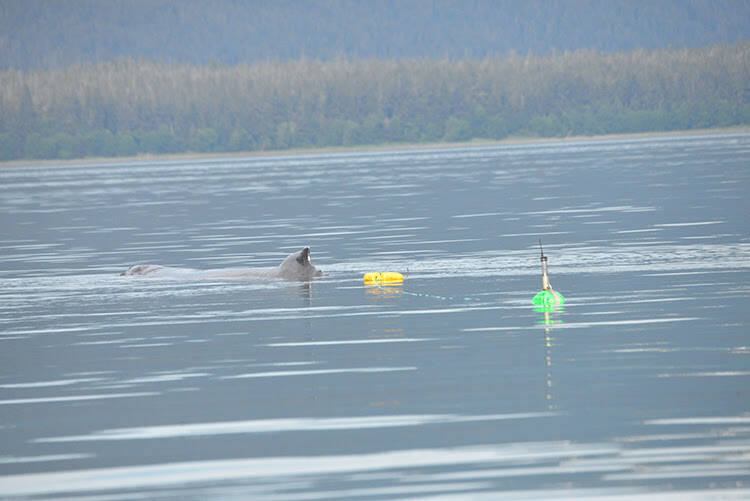Two humpback whales are separately entangled in fishing and crab pot lines in the Juneau area, the National Marine Fisheries Service Alaska region reported Thursday.
Officials are now seeking reported sightings of the whales following initial reports of the entanglements on Monday.
The first whale entangled is named “Manunauna” and is well known to the Juneau area — often seen feeding on herring near Statter Harbor and lunge feeding in Fritz Cove. On Monday morning it was reported the whale appeared to be ensnared in a Dungeness crab pot line near the North Douglas boat ramp.
According to Sadie Wright, the large whale entanglement response coordinator for NOAA Fisheries Alaska Region, a collaborative effort between multiple agencies led to the successful attachment of a satellite tag buoy to the entangling material attached to Manunauna later that day.
According to the tracker, Manunauna is on the move outside of the Juneau area, headed south in Chatham Strait and now south of Admiralty Island.
The second whale entangled was also reported late Monday morning by a fisherman who said the unidentified whale had become entangled in their gillnet while they were fishing in Taku Inlet, damaging his vessel in the process.
Crew members of the fisherman’s boat were able to cut off some of the nets, but the whale swam away with up to 100 feet of gillnet and cork line still wrapped around its flukes.
“We know less about this second animal,” said Suzie Teerlink, marine mammal specialist with NOAA Fisheries Alaska Region. “It was estimated to be about 35 feet in length. We are asking the public to provide photos of this entangled whale so we can better assess the entanglement and perhaps identify the whale.”
Wright said in an interview Thursday that Alaska receives an average of about 20 reports of whale entanglements a year. She said most often whales can free themselves from the entanglements within a matter of days and that will likely be the case with the two whales currently ensnared.
Wright said the amount of whales that get become entangled in fishing gear in Alaska is likely much higher than the estimated 20 reported sightings.
“We know that the rate of entanglement is much higher due to scar studies that researchers will photo document of whales in the wild,” she said. “They’ve seen that between 20 and 80% of humpback whales show scars and that is evidence that they’ve been entangled in the past — so we know that the number of entanglements is much higher than the reports that we receive and those are animals that have been able to free themselves.”
Wright said to reduce the likelihood of future entanglements, it’s recommended “whenever possible that people use lead line or sinking line and not floating line.”
“That gets that slack out of line and really lessens the encounter rate for whales,” she said, noting that even then there is still a chance that a whale could get entangled, which was the case for Manunauna on Monday. She said removing line from the water when not in use is another way to prevent future entanglements.
Wright encouraged the public to share any sightings of the whales, but emphasized the importance of not taking any hands-on response actions if spotted.
“In large part, we’re asking the public to let us know when they see entanglements and send us photos taken from a distance — a safe distance of over 100 yards — because we want to know about those entanglements,” she said. “But what we don’t want is people putting themselves at risk by getting closer than that to the animals.”
Reported sightings can be made to the Alaska Marine Mammal 24/7 hotline at (877) 925-7773, or the U.S. Coast Guard on VHF Channel 16.
• Contact reporter Clarise Larson at clarise.larson@juneauempire.com or (651) 528-1807.

